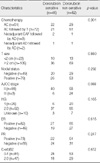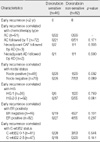Abstract
Purpose
An in vitro adenosine triphosphate-based chemotherapy response assay (ATP-CRA) was designed to require only a limited number of cells and shorten test turnaround time with a high success rate. This study investigated the correlation between in vitro doxorubicin sensitivity of tumor cells and early systemic recurrence, defined as recurrence within 2 years after surgery.
Methods
From January 2004 to March 2007, the ATP-CRA for doxorubicin was tested in 128 patients among breast cancer patients treated at Gangnam Severance Hospital, Seoul, Korea. The American Joint Committee on Cancer stages for all patients were II and III. All patients received doxorubicin-based chemotherapy. Selected patients were divided into a chemosensitive group and a non-chemosensitive group, according to a 40% cell death rate as a cut-off value. We analyzed the relationship between chemosensitivity and early systemic recurrence in patients with breast cancer.
Results
The mean age of the patients investigated was 44.6-years-old, the mean follow-up period was 39.9 months, and recurrence free survival was 38.6 months. Thirteen recurrences were observed during follow-up. Among 13 patients with a recurrence, eight had a recurrence within 2 years (early recurrence). All of the early recurring patients belonged to the non-sensitive group. Doxorubicin sensitivity results measured by ATP-CRA were related with early recurrence free survival in patients with breast cancer (p=0.030). The mean cell death rate derived from the ATP-CRA for the early recurrence group tended to be lower than that of the non-early recurrence group, but the difference was not statistically significant (p=0.05).
Figures and Tables
 | Figure 1Kaplan-Meier survival estimation graph according to doxorubicin sensitivity measured by ATP-CRA (A, Recurrence free survival; B, Early recurrence free survival). |
 | Figure 2Comparison mean cell death rate of early recurrence cases with that of early recurrence free cases. |
References
1. Trudeau M, Charbonneau F, Gelmon K, Laing K, Latreille J, Mackey J, et al. Selection of adjuvant chemotherapy for treatment of node-positive breast cancer. Lancet Oncol. 2005. 6:886–898.

2. Early Breast Cancer Trialists' Collaborative Group (EBCTCG). Effects of chemotherapy and hormonal therapy for early breast cancer on recurrence and 15-year survival: an overview of the randomised trials. Lancet. 2005. 365:1687–1717.
3. Goldhirsch A, Wood WC, Senn HJ, Glick JH, Gelber RD. Meeting highlights: international consensus panel on the treatment of primary breast cancer. J Natl Cancer Inst. 1995. 87:1441–1445.

4. Shaw GL, Gazdar AF, Phelps R, Steinberg SM, Linnoila RI, Johnson BE, et al. Correlation of in vitro drug sensitivity testing results with response to chemotherapy and survival: comparison of non-small cell lung cancer and small cell lung cancer. J Cell Biochem Suppl. 1996. 24:173–185.

5. Xu JM, Song ST, Tang ZM, Jiang ZF, Liu XQ, Zhou L, et al. Predictive chemotherapy of advanced breast cancer directed by MTT assay in vitro. Breast Cancer Res Treat. 1999. 53:77–85.

6. Kurbacher CM, Cree IA, Bruckner HW, Brenne U, Kurbacher JA, Müller K, et al. Use of an ex vivo ATP luminescence assay to direct chemotherapy for recurrent ovarian cancer. Anticancer Drugs. 1998. 9:51–57.

7. Loizzi V, Chan JK, Osann K, Cappuccini F, DiSaia PJ, Berman ML. Survival outcomes in patients with recurrent ovarian cancer who were treated with chemoresistance assay-guided chemotherapy. Am J Obstet Gynecol. 2003. 189:1301–1307.

8. Kang HJ, Hong SH, Son BH, Yoon HS, Gong GY, Ahn SH. Correlation of immunohistochemical expression of MDR1, MRP1, topoisomerase IIalpha with prognostic factors and histoculture drug response assay (HDRA) result in breast carcinoma. J Korean Breast Cancer Soc. 2004. 7:228–235.

9. Cree IA, Kurbacher CM. Individualizing chemotherapy for solid tumors--is there any alternative? Anticancer Drugs. 1997. 8:541–548.
10. Sharma S, Neale MH, Di Nicolantonio F, Knight LA, Whitehouse PA, Mercer SJ, et al. Outcome of ATP-based tumor chemosensitivity assay directed chemotherapy in heavily pre-treated recurrent ovarian carcinoma. BMC Cancer. 2003. 3:19.

11. Kawamura H, Ikeda K, Takiyama I, Terashima M. The usefulness of the ATP assay with serum-free culture for chemosensitivity testing of gastrointestinal cancer. Eur J Cancer. 1997. 33:960–966.

12. Konecny G, Crohns C, Pegram M, Felber M, Lude S, Kurbacher C, et al. Correlation of drug response with the ATP tumorchemosensitivity assay in primary FIGO stage III ovarian cancer. Gynecol Oncol. 2000. 77:258–263.

13. Koechli OR, Avner BP, Sevin BU, Avner B, Perras JP, Robinson DS, et al. Application of the adenosine triphosphate-cell viability assay in human breast cancer chemosensitivity testing: a report on the first results. J Surg Oncol. 1993. 54:119–125.

14. Choi SK, Jeong J, Lee SA, Hwang SH, Ahn SG, Jung WH, et al. Heterogeneous chemosensitivity of breast cancer determined by adeonsine triphosphate based chemotherapy response assay. J Breast Cancer. 2010. 13:180–186.

15. Sevin BU, Peng ZL, Perras JP, Ganjei P, Penalver M, Averette HE. Application of an ATP-bioluminescence assay in human tumor chemosensitivity testing. Gynecol Oncol. 1988. 31:191–204.

16. Andreotti PE, Cree IA, Kurbacher CM, Hartmann DM, Linder D, Harel G, et al. Chemosensitivity testing of human tumors using a microplate adenosine triphosphate luminescence assay: clinical correlation for cisplatin resistance of ovarian carcinoma. Cancer Res. 1995. 55:5276–5282.
17. Maehara Y, Anai H, Tamada R, Sugimachi K. The ATP assay is more sensitive than the succinate dehydrogenase inhibition test for predicting cell viability. Eur J Cancer Clin Oncol. 1987. 23:273–276.

18. Petty RD, Sutherland LA, Hunter EM, Cree IA. Comparison of MTT and ATP-based assays for the measurement of viable cell number. J Biolumin Chemilumin. 1995. 10:29–34.

19. Koo JS, Jung W, Jeong J. The predictive role of E-cadherin and androgen receptor on in vitro chemosensitivity in triple-negative breast cancer. Jpn J Clin Oncol. 2009. 39:560–568.

20. Kim HA, Yom CK, Moon BI, Choe KJ, Sung SH, Han WS, et al. The use of an in vitro adenosine triphosphate-based chemotherapy response assay to predict chemotherapeutic response in breast cancer. Breast. 2008. 17:19–26.

21. Moreno-Aspitia A, Perez EA. Treatment options for breast cancer resistant to anthracycline and taxane. Mayo Clin Proc. 2009. 84:533–545.





 PDF
PDF Citation
Citation Print
Print






 XML Download
XML Download